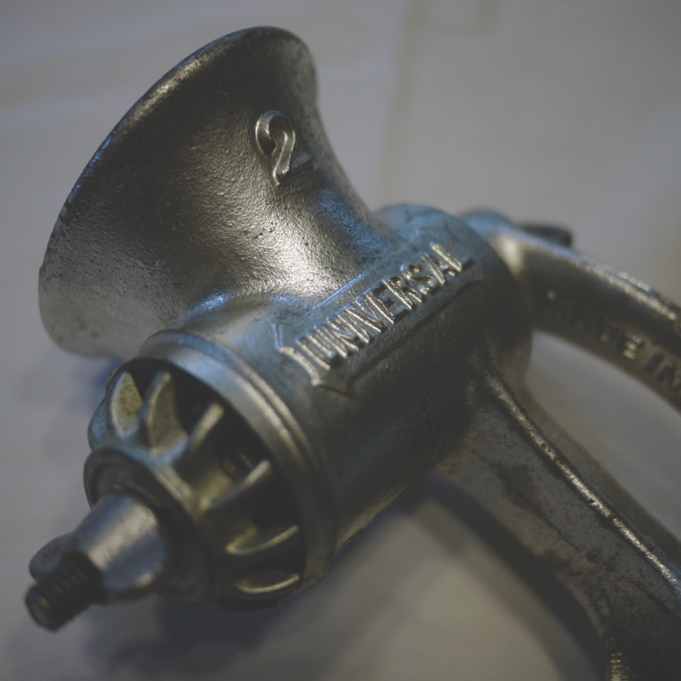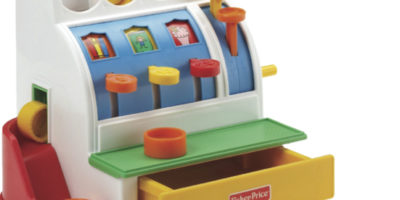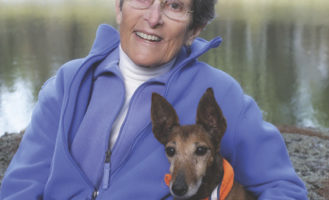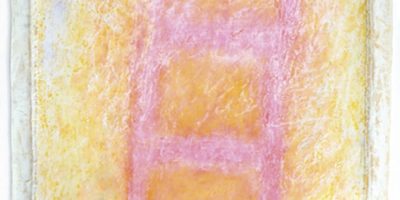
Flesh and Blood
My father's meat grinder
I wish I had the wooden slat-board, impregnated with blood and salt, that my mother used for kashering meat. Instead, it’s the grinder that remains, a secondary object—it even says #2—made of cast iron, impervious, resistant; my father’s, not my mother’s, object, since he ground the meat. That’s how I remember it, anyway, him still standing in his overcoat prickly with the cold, forcing the chuck into the open cup of the grinder with a short wooden dowel; the crank first resisting, then, with a push and a jerk of the arm, giving way. And the pink spirals of meat working their way out of the shuttlecock exit, its protruding screw like a steel nipple.
Are objects like their users? For the grinder is heavy, complex, like my father, with its gears and coils; the screws that affix to a table or countertop, that lovely butterfly-like widget. Not like my mother: salt, blood. Primary.
There are scars in the surface of the grinder, now that I look, small dark chips in the silver patina bespeaking years of use, imperfection. And the handle, made of light weathered wood in the shape of a candle flame—surely the handle must still bear the imprint of my father’s beautiful fingers. The grinder says universal, but growing up, I didn’t know anyone else who had one. Or had meat that spilled blood, like my mother’s did, in the middle of the night, slabs of veined beef and lamb, layered with fat, heavily sprinkled with coarse salt, draining from a wooden board into the double-bowled sink, down through the pipes into the bowels of our suburban house.
Meat seemed an intimate thing, and the way your family dealt with it was no one else’s business. In the early- to mid-sixties, when I grew up, it was like sex, or your parents’ divorce, or the child our neighbors had placed in an institution: unmentionable. We were kosher, yet I don’t remember ever confiding to anyone that there was blood in our kitchen at night. Nor did I mention the fat fingers of flesh that forced their way through the guts of the grinder, or the livers my mother placed in a two-handled grill that she held over the gas burner till it turned black and glowed. These were rituals that siphoned off the final life-blood, the flicker of the spirit that still remained.
Perhaps the intimacy came from shame about eating meat at all; in the Garden of Eden, it is said, man and woman were vegetarian. To me, blood seemed a guilty secret.
My mother was the one who did the kashering, but meat was my father’s heritage. In the Old Country, in Kamianets-Podolsk, Ukraine, in the Pale of Settlement, my grandfather Naftali was a kosher butcher, trained in a strange and technical art.
For example, Jews are forbidden to eat the sciatic nerve. Why? Because Jacob, in the Bible, wrestled with an angel one night before meeting up with his brother Esau, from whom he’d stolen their father’s birthright. The angel (both literal being and conscience) wounds Jacob in the thigh…which leads, centuries later, to an addendum to the laws of kashrut. Not only must an animal be slaughtered humanely and quickly, with a knife to the throat, not only must the meat be salted and drained of blood before being eaten, but the sciatic nerve must be excised to commemorate Jacob’s wound, and only someone exceedingly skilled knows how to do this.
Because of his central role in ritual, the shochet was an important figure in the Jewish community. In small communities in Europe, the rabbi and shochet were often the same person, a person not only well-trained in Jewish law, but also pious. And, of course, the shochet had to be a man.
It made sense that in our household the buying of meat was an important job, a man’s job, not something, certainly, relegated to my mother. When my grandfather landed in this country, he set up a butcher shop, first on the Lower East Side and then, after ill-fated stints as the owner of a stable and then of a bedspring factory, he opened another store selling kosher meat in the Bronx, on Featherbed Lane.
During the Depression, when Naftali became ill and almost lost the store, my father, still a teenager, took over the books. I still have some of the now-crumbling account logs, as well as receipts from suppliers like Ida Frank, poulterer, and Sam Goldstein on Mt. Eden Avenue, who charged for a whole side of veal.
And so my father, who eventually used his facility with numbers to work as a businessman, was left, still, with his father’s inheritance. All his life he retained a feeling for meat, an interest in looking at it and judging it and talking about it. These days most people don’t spend time doing that; we just throw lamb chops into our shopping carts at the supermarket. When you observe kashrut, though, you’re a little closer to meat. You don’t get your meat in the supermarket, at least you didn’t in those days. You thought about meat much more than other people did. This kind of thinking almost never takes place in a regular grocery store, even now.
In those years we always went to a kosher butcher, about five miles from our house, near Mott Avenue in Far Rockaway, when it was still a largely Jewish place and there was a bustling shopping avenue. It was an event. We’d pick up my father at the subway station, all of us four girls and my mother, a few minutes earlier than usual, and we’d park in the lot at the back of Loehmann’s and cut through the store, and on the other side of the big street—Cornaga? Central?—was Sam’s. It was run by a big Jewish man with a mustache, perhaps the same Sam Goldstein from the Bronx, since my father seemed comfortably intimate with him. My father got along with Sam in the usual way he got along with everyone: he fought with him.
❈❈❈
What did they fight about? Who knows? The cut or quality of meat, the amount of fat Sam managed to cut away, the beauty or lack thereof in a loin or a chop or a foreleg of lamb. Above all, the price, for how could one not barter for something so precious? Perhaps no one but my father was as capable of making such a simple transaction into a life-or-death melodrama. Yet it was like a play, where even though one actor was wielding a knife, the other did not take the threats or fury too seriously.
I did not make noise or trouble at the butcher store; none of us did. I’d push the sawdust back and forth with the side of my shoe; there was something magical in the way it separated and then clung together, as though by magnetism. I’d look out on the street where it was growing dark. I’d think of how disgusting the piece of tongue was, sitting there in the glass case, a real tongue cut out of a cow’s mouth.
A fishmonger, about whom I remember little, except that we never bought fish from him, owned half the store. I think I had fresh fish two or three times during my childhood, despite the fact that we lived so close to the ocean. This was the era of meat; we ate steak several times a week, and had no idea what an eggplant was. Fish was something you bought in a frozen block from the supermarket or in breaded fish-stick form. At the butcher store, I looked into those bleary fish eyes as though into the eyes of aliens.
I know I am misremembering this, this vision of my father arriving home after we’d returned from the butcher and immediately, without removing his coat, beginning to grind meat, throwing in a whole onion and some garlic besides. I know because the meat had not been kashered yet, so it was not possible to grind it. But there was something about the grinding that seemed essential, as though it were a necessity that had to be dealt with immediately.
Certainly I do know that my mother would right away open the bags from the butcher, unfold the brown paper in which the meat had been wrapped, grab the pieces and throw them into a large washtub filled with water. Later, when most of the blood had been washed out, she’d take out the pieces one by one to salt them. Then she’d grab them one by one once more and slap them down on the board to drain. It seemed one of those instinctive things she just knew how to do, something women knew how to do.
I swore I would never touch raw meat.
❈❈❈
As it was meant to, kashrut set our family apart, not only from non-Jews, of whom I knew few, but also from the largely non-religious Jewish community in which we lived, which had mostly left behind these antiquated customs in Europe or Brooklyn.
We four sisters were “those smart girls,” those girls who didn’t ride on the Sabbath, the girls who would never consider hanging around with the Italian boys, laughing and smoking in front of the Central Avenue diner. Invited to a classmate’s birthday party at the Hamburger Express, where the electric train ran down the counter delivering hamburgers, we sisters would have to accept the delivery of something specially made for us—insipid tuna salad on toast.
My grandparents are buried with my father’s family in Queens, in a huge cemetery where the Grand Central Parkway and the Long Island Expressway intersect, in the shadow of the 1964 World’s Fair remnant, the Unisphere. The cemetery has streets marked by little wooden signs on posts, and hundreds of tombstones with names like Katz and Rosen and Mandelbaum. Some have that symbol that says “he died too soon,” with the detached limb of a tree. Very few have flowers, but many have small stones left by a friend or family member. I don’t recall coming here when I was a child—my parents did not let us attend the burials of our relatives—and when the family comes now, for a funeral or unveiling, we always get lost.
But we know we’re there when we get to the stone arch that was erected by the Jagolnizer Burial Society. My family is buried just behind this arch, two rows back. We stumble on the uneven ground but find them: my grandparents, Adele and Naftali Wolfsohn; my father; his three sisters, Sylvia and Diana and Esther; and Diana’s little son, Edward, who died at the age of one-and-a-half, for whom there is just a tiny marker. My mother, subsumed by my father’s
family, is here, too.
Naftali, widowed early, had left Ukraine as a young man to find a new wife across the border, in Jagolnizer, Austria, and it was there, on his first day, walking about on the streets with a companion, that he spotted a beautiful young woman on a balcony above.
“That is the woman I will marry,” he told his companion, and even when he discovered she was the daughter of the mayor, he was not deterred. Naftali, a gentle man with a ramrod spine, married her, and they came to America, where he continued his work as butcher and she became a suffragette.
The Jagolnizer section in the cemetery is a strange little stone village of dead people, made even stranger, I think, by the knowledge that there is no longer a Jagolnizer in Europe, at least not a Jewish one. That community is, as it were, dead and buried, while, this one, oddly, lives on.
Standing before all their graves, I remember my grandfather, my father, my mother, and my aunts all in one breath, and leave whatever stones I can find on the hard ground.
❈❈❈
Now I think about meat only twice a year, on Passover and Hanukkah. Before Passover, despite my almost complete lack of observance the rest of the year, I engage in the ritualistic cleaning of my household, changing dishes, vacuuming my car, emptying pockets of old candy wrappers, and, finally, sweeping hametz into a paper bag with a feather and wooden spoon.
And I buy kosher meat: chickens, flanken, a fatty brisket for the seder. I go to a butcher, a few miles from my home in the New York suburbs, but it is nothing like Sam’s: Saran-coated cuts of beef and lamb sit on their Styrofoam trays in low, coolly-lit display cases. There’s no old-fashioned, butcher-block counter where Sam stands, and no fish. It’s a small, narrow place in a strip mall. The other customers and I push around squeaky supermarket wagons that seem to have been sequestered from a variety of nearby stores, and we eye each other warily. I am sure I will commit some kashrus error. My only interaction with the butcher himself, who appears momentarily from his inner abattoir in his blood-spattered apron, is my meek request for a shank bone.
But my husband, who buys and prepares a whole brisket on Hanukkah (kosher mostly for the benefit of my relatives and friends), goes to a different butcher and carries on my father’s tradition. Like my father, he’s a man of science and a stubborn soul. He speaks directly to the butcher—who, it’s true, hides behind a sliding glass window like a cashier in a sketchy neighborhood—and gets himself just the right combination of sinew and fat; the meat-man gets out his big knife and trims the beef and wraps it in brown paper; they haggle over the price. Still, there is no sawdust and no melodrama, and even though the brisket, marinated and fussed over and cooked at a slow braise for hours as per directions in Cook’s magazine, is more delicious than my father ever dreamed of, the meat, pre-kashered, pre-salted, is no longer prelapsarian.
My mother died eight years ago and I inherited my father’s meat grinder: a reminder, literally, of flesh and blood. It sits on its side, an object of beauty, in my non-kosher kitchen; a steely, quirky relic of family and community and maleness and history, when the shochet, the ritual slaughterer, as in the Passover song, “Had Gadya,” was only one step down in importance from the Angel of Death and only two from the Holy One, Blessed be He.
Penny Wolfson is working on an M.A. in decorative arts and design history at Parsons The New School for Design. Her writing has appeared in The New York Times, The Atlantic, and Print, and in anthologies, including Best American Essays 2001. She is the author of Moonrise: One Family, Genetic Identity, and Muscular Dystrophy.





